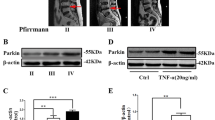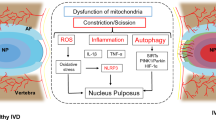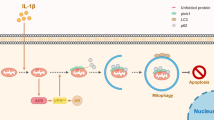Abstract
Intervertebral disc (IVD) cell apoptosis has been suggested to play an important role in promoting the degeneration process. It has been demonstrated that IVD cell apoptosis occurs through either death receptor, mitochondrial or endoplasmic reticulum (ER) pathway. Our study aimed to explore the relationship among these three pathways and grade of IVD degeneration (IVDD). IVDs were collected from patients with lumbar fracture, vertebral tumor, disc herniation or spondylolisthesis. IVDs were distinguished by MRI and histomorphological examination, cell apoptosis was detected by TUNEL staining. Biomarkers of these three apoptosis pathways were detected by RT-PCR and Western blot. Furthermore, the correlation between apoptosis pathways biomarkers and disc pathology were analyzed. Nucleus pulposus cell density decreased with degeneration process, and increased apoptotic ratio. ER pathway was predominant in mild stage of IVDD (GRP78, GADD153 upregulation and caspase-4 activation), death receptor pathway was predominant in mild and moderate stages (Fas, FasL up-regulation and caspase-8 activation) and mitochondrial pathway was predominant in moderate and severe stages (Bcl-2 down-regulation, Bax up-regulation, cytochrome-c accumulation in cytoplasm and caspase-9 activation). There were significant differences in the expressions of Fas, FasL, Bax, GADD153, cytochrome-c and cleaved caspase-8/9/3 between contained and non-contained discs. In conclusion, apoptosis occurs via these three apoptosis pathways together in IVDD. ER pathway plays a more critical role in the mild compared to moderate and severe stages, death receptor pathway in mild and moderate, and mitochondrial pathway in moderate and severe stages of IVDD. Disc cells apoptosis may progress rapidly after herniation, and may depend on the type of herniation.






Similar content being viewed by others
References
Macfarlane GJ, Thomas E, Croft PR, Papageorgiou AC, Jayson MI, Silman AJ (1999) Predictors of early improvement in low back pain amongst consulters to general practice: the influence of pre-morbid and episode-related factors. Pain 80(1–2):113–119
Fairbank J (2002) Clinical importance of the intervertebral disc, or back pain for biochemists. Biochem Soc Trans 30(Pt 6):829–831
Luoma K, Riihimaki H, Luukkonen R, Raininko R, Viikari-Juntura E, Lamminen A (2000) Low back pain in relation to lumbar disc degeneration. Spine 25(4):487–492
Gruber HE, Hanley EN Jr (1998) Analysis of aging and degeneration of the human intervertebral disc comparison of surgical specimens with normal controls. Spine 23(7):751–757
Gruber HE, Norton HJ, Hanley EN Jr (2000) Anti-apoptotic effects of IGF-1 and PDGF on human intervertebral disc cells in vitro. Spine 25(17):2153–2157
Park JB, Chang H, Kim KW (2001) Expression of Fas ligand and apoptosis of disc cells in herniated lumbar disc tissue. Spine 26(6):618–621
Park JB, Kim KW, Han CW, Chang H (2001) Expression of Fas receptor on disc cells in herniated lumbar disc tissue. Spine 26(2):142–146
Lee Y, Gustafsson AB (2009) Role of apoptosis in cardiovascular disease. Apoptosis 14(4):536–548
Schattenberg JM, Schuchmann M (2009) Diabetes and apoptosis: liver. Apoptosis 14(12):1459–1471
Zhao CQ, Jiang LS, Dai LY (2006) Programmed cell death in intervertebral disc degeneration. Apoptosis 11(12):2079–2088
Buckwalter JA (1995) Aging and degeneration of the human intervertebral disc. Spine 20(11):1307–1314
Ahsan R, Tajima N, Chosa E, Sugamata M, Sumida M, Hamada M (2001) Biochemical and morphological changes in herniated human intervertebral disc. J Orthop Sci 6(6):510–518
Schulze-Osthoff K, Ferrari D, Los M, Wesselborg S, Peter ME (1998) Apoptosis signaling by death receptors. Eur J Biochem 254(3):439–459
Ding HF, Fisher DE (2001) p53, caspase 8, and regulation of apoptosis after ionizing radiation. J Pediatr Hematol Oncol 23(3):185–188
Green DR, Kroemer G (2004) The pathophysiology of mitochondrial cell death. Science 305(5684):626–629
Crompton M (1999) The mitochondrial permeability transition pore and its role in cell death. Biochem J 341(Pt 2):233–249
Rasola A, Bernardi P (2007) The mitochondrial permeability transition pore and its involvement in cell death and in disease pathogenesis. Apoptosis 12(5):815–833
Tsujimoto Y, Shimizu S (2007) Role of the mitochondrial membrane permeability transition in cell death. Apoptosis 12(5):835–840
Zou H, Li Y, Liu X, Wang X (1999) An APAF-1.cytochrome c multimeric complex is a functional apoptosome that activates procaspase-9. J Biol Chem 274(17):11549–11556
Kaufman RJ (1999) Stress signaling from the lumen of the endoplasmic reticulum: coordination of gene transcriptional and translational controls. Genes Dev 13(10):1211–1233
Szegezdi E, Logue SE, Gorman AM, Samali A (2006) Mediators of endoplasmic reticulum stress-induced apoptosis. EMBO Rep 7(9):880–885
Kozutsumi Y, Segal M, Normington K, Gething MJ, Sambrook J (1988) The presence of malfolded proteins in the endoplasmic reticulum signals the induction of glucose-regulated proteins. Nature 332(6163):462–464
Zhao CQ, Zhang YH, Jiang SD, Jiang LS, Dai LY (2010) Both endoplasmic reticulum and mitochondria are involved in disc cell apoptosis and intervertebral disc degeneration in rats. Age (Dordr) 32(2):161–177
Hitomi J, Katayama T, Eguchi Y, Kudo T, Taniguchi M, Koyama Y, Manabe T, Yamagishi S, Bando Y, Imaizumi K, Tsujimoto Y, Tohyama M (2004) Involvement of caspase-4 in endoplasmic reticulum stress-induced apoptosis and abeta-induced cell death. J Cell Biol 165(3):347–356
Zou H, Henzel WJ, Liu X, Lutschg A, Wang X (1997) Apaf-1, a human protein homologous to C. elegans CED-4, participates in cytochrome c-dependent activation of caspase-3. Cell 90(3):405–413
Krammer PH (1999) CD95(APO-1/Fas)-mediated apoptosis: live and let die. Adv Immunol 71:163–210
Morishima N, Nakanishi K, Takenouchi H, Shibata T, Yasuhiko Y (2002) An endoplasmic reticulum stress-specific caspase cascade in apoptosis. Cytochrome c-independent activation of caspase-9 by caspase-12. J Biol Chem 277(37):34287–34294
Luo X, Budihardjo I, Zou H, Slaughter C, Wang X (1998) Bid, a Bcl2 interacting protein, mediates cytochrome c release from mitochondria in response to activation of cell surface death receptors. Cell 94(4):481–490
Liu H, Zhu H, Xu CJ, Yuan J (1998) Cleavage of BID by caspase 8 mediates the mitochondrial damage in the Fas pathway of apoptosis. Cell 94(4):491–501
Ghribi O, Herman MM, DeWitt DA, Forbes MS, Savory J (2001) Abeta(1–42) and aluminum induce stress in the endoplasmic reticulum in rabbit hippocampus, involving nuclear translocation of gadd 153 and NF-kappaB. Brain Res Mol Brain Res 96(1–2):30–38
Rao RV, Castro-Obregon S, Frankowski H, Schuler M, Stoka V, del Rio G, Bredesen DE, Ellerby HM (2002) Coupling endoplasmic reticulum stress to the cell death program. An Apaf-1-independent intrinsic pathway. J Biol Chem 277(24):21836–21842
Chen B, Fellenberg J, Wang H, Carstens C, Richter W (2005) Occurrence and regional distribution of apoptosis in scoliotic discs. Spine 30(5):519–524
Park JB, Park IC, Park SJ, Jin HO, Lee JK, Riew KD (2006) Anti-apoptotic effects of caspase inhibitors on rat intervertebral disc cells. J Bone Joint Surg Am 88(4):771–779
Han D, Ding Y, Liu SL, Wang G, Si IC, Wang X, Cui L, Huang D (2009) Double role of Fas ligand in the apoptosis of intervertebral disc cells in vitro. Acta Biochim Biophys Sin (Shanghai) 41(11):938–947
Inui Y, Nishida K, Doita M, Takada T, Miyamoto H, Yoshiya S, Kurosaka M (2004) Fas-ligand expression on nucleus pulposus begins in developing embryo. Spine 29(21):2365–2369
Takada T, Nishida K, Doita M, Kurosaka M (2002) Fas ligand exists on intervertebral disc cells: a potential molecular mechanism for immune privilege of the disc. Spine 27(14):1526–1530
Wang J, Tang T, Yang H, Yao X, Chen L, Liu W, Li T (2007) The expression of Fas ligand on normal and stabbed-disc cells in a rabbit model of intervertebral disc degeneration: a possible pathogenesis. J Neurosurg Spine 6(5):425–430
Rannou F, Lee TS, Zhou RH, Chin J, Lotz JC, Mayoux-Benhamou MA, Barbet JP, Chevrot A, Shyy JY (2004) Intervertebral disc degeneration: the role of the mitochondrial pathway in annulus fibrosus cell apoptosis induced by overload. Am J Pathol 164(3):915–924
Heyde CE, Tschoeke SK, Hellmuth M, Hostmann A, Ertel W, Oberholzer A (2006) Trauma induces apoptosis in human thoracolumbar intervertebral discs. BMC Clin Pathol 6:5
Tschoeke SK, Hellmuth M, Hostmann A, Robinson Y, Ertel W, Oberholzer A, Heyde CE (2008) Apoptosis of human intervertebral discs after trauma compares to degenerated discs involving both receptor-mediated and mitochondrial-dependent pathways. J Orthop Res 26(7):999–1006
Park JB, Lee JK, Park SJ, Kim KW, Riew KD (2005) Mitochondrial involvement in fas-mediated apoptosis of human lumbar disc cells. J Bone Joint Surg Am 87(6):1338–1342
Zhang YH, Zhao CQ, Jiang LS, Dai LY (2010) Lentiviral shRNA silencing of CHOP inhibits apoptosis induced by cyclic stretch in rat annular cells and attenuates disc degeneration in the rats. Apoptosis 16(6):594–605
Pfirrmann CW, Metzdorf A, Zanetti M, Hodler J, Boos N (2001) Magnetic resonance classification of lumbar intervertebral disc degeneration. Spine 26(17):1873–1878
Fardon DF, Milette PC (2001) Nomenclature and classification of lumbar disc pathology. Recommendations of the combined task forces of the North American spine society, American society of spine radiology, and American society of neuroradiology. Spine 26(5):E93–E113
Gougeon ML, Montagnier L (1993) Apoptosis in AIDS. Science 260(5112):1269–1270
Chauvier D, Lecoeur H, Langonne A, Borgne-Sanchez A, Mariani J, Martinou JC, Rebouillat D, Jacotot E (2005) Upstream control of apoptosis by caspase-2 in serum-deprived primary neurons. Apoptosis 10(6):1243–1259
Kroemer G, Reed JC (2000) Mitochondrial control of cell death. Nat Med 6(5):513–519
Thompson JP, Pearce RH, Schechter MT, Adams ME, Tsang IK, Bishop PB (1990) Preliminary evaluation of a scheme for grading the gross morphology of the human intervertebral disc. Spine 15(5):411–415
Peng B, Chen J, Kuang Z, Li D, Pang X, Zhang X (2009) Expression and role of connective tissue growth factor in painful disc fibrosis and degeneration. Spine 34(5):E178–E182
Sobajima S, Kompel JF, Kim JS, Wallach CJ, Robertson DD, Vogt MT, Kang JD, Gilbertson LG (2005) A slowly progressive and reproducible animal model of intervertebral disc degeneration characterized by MRI, X-ray, and histology. Spine 30(1):15–24
Cappello R, Bird JL, Pfeiffer D, Bayliss MT, Dudhia J (2006) Notochordal cell produce and assemble extracellular matrix in a distinct manner, which may be responsible for the maintenance of healthy nucleus pulposus. Spine 31(8):873–882 discussion 883
Suda T, Takahashi T, Golstein P, Nagata S (1993) Molecular cloning and expression of the Fas ligand, a novel member of the tumor necrosis factor family. Cell 75(6):1169–1178
Aszodi A, Chan D, Hunziker E, Bateman JF, Fassler R (1998) Collagen II is essential for the removal of the notochord and the formation of intervertebral discs. J Cell Biol 143(5):1399–1412
Kim KW, Kim YS, Ha KY, Woo YK, Park JB, Park WS, An HS (2005) An autocrine or paracrine Fas-mediated counterattack: a potential mechanism for apoptosis of notochordal cells in intact rat nucleus pulposus. Spine 30(11):1247–1251
Kaneyama S, Nishida K, Takada T, Suzuki T, Shimomura T, Maeno K, Kurosaka M, Doita M (2008) Fas ligand expression on human nucleus pulposus cells decreases with disc degeneration processes. J Orthop Sci 13(2):130–135
Ming L, Wang P, Bank A, Yu J, Zhang L (2006) PUMA dissociates Bax and Bcl-X(L) to induce apoptosis in colon cancer cells. J Biol Chem 281(23):16034–16042
Vaux DL, Cory S, Adams JM (1988) Bcl-2 gene promotes haemopoietic cell survival and cooperates with c-myc to immortalize pre-B cells. Nature 335(6189):440–442
Sudo H, Minami A (2010) Regulation of apoptosis in nucleus pulposus cells by optimized exogenous Bcl-2 overexpression. J Orthop Res 28(12):1608–1613
Fischer H, Koenig U, Eckhart L, Tschachler E (2002) Human caspase 12 has acquired deleterious mutations. Biochem Biophys Res Commun 293(2):722–726
Dong D, Ni M, Li J, Xiong S, Ye W, Virrey JJ, Mao C, Ye R, Wang M, Pen L, Dubeau L, Groshen S, Hofman FM, Lee AS (2008) Critical role of the stress chaperone GRP78/BiP in tumor proliferation, survival, and tumor angiogenesis in transgene-induced mammary tumor development. Cancer Res 68(2):498–505
Sun FC, Wei S, Li CW, Chang YS, Chao CC, Lai YK (2006) Localization of GRP78 to mitochondria under the unfolded protein response. Biochem J 396(1):31–39
Zhang YH, Zhao CQ, Jiang LS, Dai LY (2011) Cyclic stretch-induced apoptosis in rat annulus fibrosus cells is mediated in part by endoplasmic reticulum stress through nitric oxide production. Eur Spine J. doi: 10.1007/s00586-011-1718-5
Schuler M, Green DR (2001) Mechanisms of p53-dependent apoptosis. Biochem Soc Trans 29(Pt 6):684–688
Bennett M, Macdonald K, Chan SW, Luzio JP, Simari R, Weissberg P (1998) Cell surface trafficking of Fas: a rapid mechanism of p53-mediated apoptosis. Science 282(5387):290–293
Martin LJ, Chen K, Liu Z (2005) Adult motor neuron apoptosis is mediated by nitric oxide and Fas death receptor linked by DNA damage and p53 activation. J Neurosci 25(27):6449–6459
Mattson MP (2000) Apoptosis in neurodegenerative disorders. Nat Rev Mol Cell Biol 1(2):120–129
Acknowledgment
This study was supported by a grant from the National Natural Science Foundation of China (81071511).
Author information
Authors and Affiliations
Corresponding author
Electronic supplementary material
Below is the link to the electronic supplementary material.
Rights and permissions
About this article
Cite this article
Wang, H., Liu, H., Zheng, ZM. et al. Role of death receptor, mitochondrial and endoplasmic reticulum pathways in different stages of degenerative human lumbar disc. Apoptosis 16, 990–1003 (2011). https://doi.org/10.1007/s10495-011-0644-7
Published:
Issue Date:
DOI: https://doi.org/10.1007/s10495-011-0644-7




